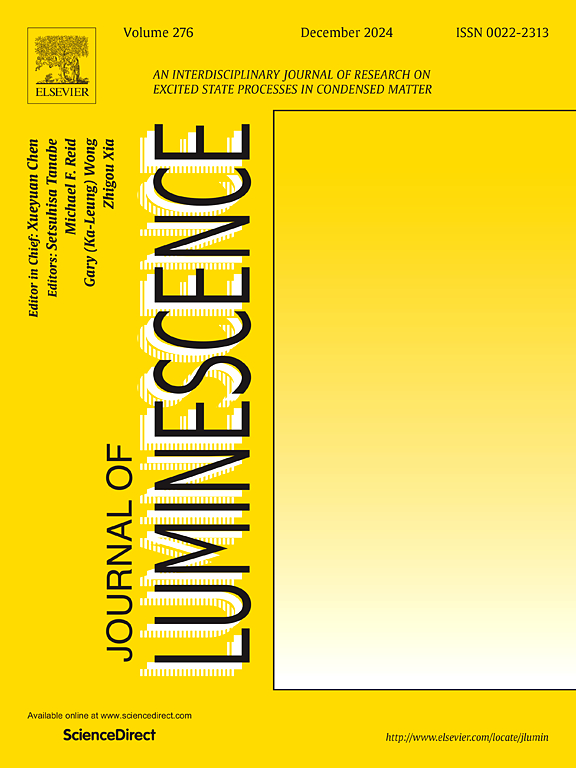Eu3+掺杂la -邻苯二甲酸盐配合物的光致发光性质研究
IF 3.3
3区 物理与天体物理
Q2 OPTICS
引用次数: 0
摘要
采用易湿化学法合成了公式为Na2La2(PA)4:Eu3+ (PA =邻苯二甲酸阴离子)的Eu3+掺杂la -邻苯二甲酸配合物。采用XRD、FTIR、TGA和光致发光技术对配合物进行了分析。当Eu3+含量为2.5 wt%时,该配合物表现出较强的红光发射,寿命长(~ 2140 μs)。与未掺杂配合物(Eu2(PA)3;3H2O)相比,由于非辐射失活途径过程大幅减少,掺杂配合物的光致发光量子产率提高了近20倍,达到了80%左右。不同发射参数对5D0排放水平的Eu3+样辐射、非辐射跃迁速率、Judd-Ofelt参数也进行了确定。CIE颜色坐标结果(0.652,0.348)表明所制备的荧光粉接近国家电视系统委员会(NTSC)(0.67, 0.33)。新合成的Eu3+掺杂的la -邻苯二甲酸盐配合物将为开发高效发红光有机荧光粉铺平道路。本文章由计算机程序翻译,如有差异,请以英文原文为准。
Investigations of photoluminescence properties of Eu3+ doped La-phthalate complexes
Eu3+ doped La-Phthalic acid complexes with the formula Na2La2(PA)4:Eu3+ (PA = phthalate anion) are synthesized through a facile wet chemical method. The complexes are analysed by using XRD, FTIR, TGA and photoluminescence techniques. The complex exhibits strong red emission with long lifetime (∼2140 μs) at 2.5 wt% of Eu3+ content. Compared to its parent complex i.e. un-doped complex (Eu2(PA)3;3H2O), the doped complex displays improved and exceptionally high photoluminescence quantum yield (about 80 %), which is nearly 20 times stronger than un-doped complex as non-radiative deactivation pathway process decreases substantially. Different emission parameters of 5D0 emission level of Eu3+ like radiative, non-radiative transition rates, Judd-Ofelt parameters are also determined. The CIE colour coordinates result (0.652, 0.348) reveals that the prepared phosphor is close to the National Television System Committee (NTSC) (0.67, 0.33). The newly synthesized Eu3+ doped La-Phthalate complex will pave a pathway for developing highly efficient red emitting organic phosphor.
求助全文
通过发布文献求助,成功后即可免费获取论文全文。
去求助
来源期刊

Journal of Luminescence
物理-光学
CiteScore
6.70
自引率
13.90%
发文量
850
审稿时长
3.8 months
期刊介绍:
The purpose of the Journal of Luminescence is to provide a means of communication between scientists in different disciplines who share a common interest in the electronic excited states of molecular, ionic and covalent systems, whether crystalline, amorphous, or liquid.
We invite original papers and reviews on such subjects as: exciton and polariton dynamics, dynamics of localized excited states, energy and charge transport in ordered and disordered systems, radiative and non-radiative recombination, relaxation processes, vibronic interactions in electronic excited states, photochemistry in condensed systems, excited state resonance, double resonance, spin dynamics, selective excitation spectroscopy, hole burning, coherent processes in excited states, (e.g. coherent optical transients, photon echoes, transient gratings), multiphoton processes, optical bistability, photochromism, and new techniques for the study of excited states. This list is not intended to be exhaustive. Papers in the traditional areas of optical spectroscopy (absorption, MCD, luminescence, Raman scattering) are welcome. Papers on applications (phosphors, scintillators, electro- and cathodo-luminescence, radiography, bioimaging, solar energy, energy conversion, etc.) are also welcome if they present results of scientific, rather than only technological interest. However, papers containing purely theoretical results, not related to phenomena in the excited states, as well as papers using luminescence spectroscopy to perform routine analytical chemistry or biochemistry procedures, are outside the scope of the journal. Some exceptions will be possible at the discretion of the editors.
 求助内容:
求助内容: 应助结果提醒方式:
应助结果提醒方式:


